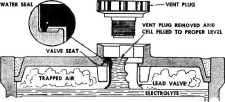1942 - 1947 CHEVROLET SHOP MANUAL
Section 12 - Electrical System
|
|
|||
|
12-5
|
|||
|
|
|||
|
when the battery is
located elsewhere. Water level
should be kept not more than 1/4" above the top
of the plates in both passenger
car and truck batteries at all times.
To prevent over-filling, each battery cell is
equipped with a non-overfill cell
cap. This device consists
of a lead sleeve in the cell opening which
is threaded in its inner diameter
for the filler cap. When the cap is screwed down into place, the lead
sleeve is lifted and held
in the upper position, uncovering
the vent passage for the cell. This permits the gases to escape
through the vent in the cap, as
shown in Fig. 9. When the filler
cap is removed for
|
greatly reduced. Never add acid
to the battery.
The specific gravity of a fully charged battery,
as indicated by a hydrometer,
should be between 1.275 and
1.300. The specific gravity of a fully discharged battery will
be approximately 1.150.
Keep the battery terminals clean, tight, and
well covered with vaseline to
prevent corrosion.
To prevent freezing in
cold weather, test the battery
frequently and see that the specific gravity is kept up to at
least 1.250. A discharged battery will
freeze at a little below the
freezing point of water.
When batteries are removed from cars or trucks
for charging, the battery is
properly vented when the
cell caps are screwed tightly in place. This note
appears on each cap: "Keep Plug
Tight While Charging."
Where cell caps are left off batteries on the
charging line to facilitate
periodic checking of specific
gravity, proper venting may be accomplished
by lifting the lead sleeve in each
cell opening and turning it
clockwise or to the right so that the two
tangs of the sleeve rest on the
raised lip of the seat. Do not fill the battery with distilled
water when the lead sleeve is in
this position.
Batteries in new cars and those carried in parts
stock should receive regular
attention in order to
prevent sulphation of the plates due to inactivity
of the battery. The following
instructions are recommended
for new cars and trucks, and batteries
in parts stock:
NEW CARS AND TRUCKS IN STOCK
1. Check
battery electrolyte on each new car or
truck received—add sufficient
distilled water to bring
the electrolyte up to not more than 1/4"
above the top of the plates in
each cell.
2. Check
the electrolyte and add distilled water
as necessary at weekly or
semi-monthly intervals,
depending upon the weather-warm
weather causes greater water loss.
3. If
the specific gravity of the battery is below 1.225, remove it
and place on the charging line.
Charge the battery until the specific gravity of the
electrolyte reaches 1.275 to 1.300.
Before a new car or
truck is delivered to a customer,
make sure the specific gravity of the battery electrolyte
measures at least 1.260 -preferably
higher. Under no circumstances
should acid be added to a
new battery to increase the specific
gravity of the electrolyte.
|
||
|
VENT HUG SCREWED INTO
VALVE RAISES IT, PERMITTING AIR AND GAS TO ESCAPE. ALSO ALLOWS ADDED
WATER TO COMBINE WITH ELECTROLYTE At THE CORRECT LEVEL
|
|||
 |
|||
|
Fig. 9-Battery
Cell Cap in Position—Vent Open
checking or filling a cell, the lead sleeve drops
down by its own weight and covers
the vent passage to the
cell. The bottom of the sleeve is then within 1/4" above the
top of the plates. Water can
only be added to each cell until
it reaches the bottom of
the sleeve; air is then trapped in the expansion chamber of the cell
because its vent is
covered, Fig. 10, thus preventing any further entry
of water to the cell. When the
filler cap is installed,
the cell vent is automatically opened as explained
in the foregoing.
Filling one cell does
not fill all, so examine each one and fill as required. If
inconvenient to obtain distilled
water, use melted artificial ice or rain
water and under no circumstances
should ordinary water be used. Do not store water for batteries
in metallic containers-use glass.
 |
|||
|
TOP OF PLATES
Ho. 10-Battery Cell Cap Removed-Vent Glased
If the solution in a battery cell falls below a
point where the plates are
exposed, the plates become
hardened and the battery capacity is
|
|||
|
|
|||